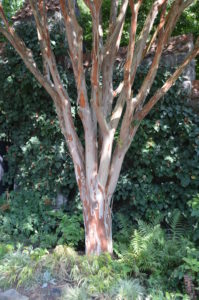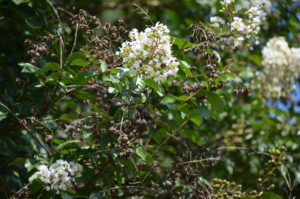In Tennessee (where I live) and in the Southeastern U.S., bad crape myrtle (Lagerstroemia x) pruning continues to be done by professional landscapers and homeowners (USDA hardiness zones 6-9). This practice, also called “topping”, reduces tree (or shrub) height. Over 25 years, Southern Living magazine called this “crape murder”.
Crape murder is not going away. More crape myrtles are improperly pruned than correctly pruned. Usually, the practice will not kill the tree, but it can result in less flowering and shorter tree life. Wood decays frequently occur.
If a crape myrtle becomes too large for a certain location, either it was planted in the wrong spot to begin with or the wrong variety was purchased. Before you plant, select crape myrtle varieties that will fit their location at maturity. That information is printed on the plant tag.
Never top crape myrtles! Generally, crape myrtles require very little annual pruning and are best pruned in late winter once the worse of the winter weather is over. Most branches only need thinning, e.g., removal of last summer’s spent flowers and seed heads. Remove any branches that cross or rub against one another. Eliminate suckers around the base of the tree and water sprouts (vigorous upright growth) inside the tree canopy.
According to Dr. Allen Owings at the LSU AgCenter, Hammond Research Station, Hammond LA, properly pruned crape myrtles exhibit:
- Stronger Branch Wood
- More Flowers
- Larger Flowers
- More Pollinating Insects
- Better Bark Features
- Fewer Water Sprouts
- Fewer Suckers
- More Birds Nesting
- Less Fungal Decay in Wood
- Fewer Insects and Sooty Mold
- Less Leaf Spot
- Better Air Circulation
Encourage friends and neighbors to prune crape myrtles properly. When allowed to grow and mature, they become beautiful majestic trees. If you do not know how to prune crape myrtles, hire a certified tree arborist where you live. Consult the International Society of Arboriculture (ISA) website for a list of certified arborists in your area.



 Posted in
Posted in 
